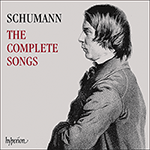
Welcome to Hyperion Records, an independent British classical label devoted to presenting high-quality recordings of music of all styles and from all periods from the twelfth century to the twenty-first.
Hyperion offers both CDs, and downloads in a number of formats. The site is also available in several languages.
Please use the dropdown buttons to set your preferred options, or use the checkbox to accept the defaults.

By 1840 Schumann could conjure pure magic on a single page in a song like Du bist wie eine Blume without putting a foot, or finger, wrong. Im Herbste (the final e does not occur in Kerner’s printed title) gives the younger composer the chance to practise this ‘perfect miniature’ style. These hushed evocations are more often in duple time than triple, and more often in flat keys rather than sharp. The music is more often than not luxuriantly languid, and the composer’s ability to come up with an unforgettable tune is tested to the hilt. Without pretending that Im Herbste achieves the perfection of Du bist wie eine Blume, the two songs have much in common: a slow tempo, conciseness (both songs are printed on a single page) and a bank of gently throbbing semiquavers in the accompaniment, a seemingly neutral background, from which the vocal line is allowed to flower like an exotic bloom.
The music for Im Herbste is very fetching. The tune is a beautiful one although it falls too much into one-bar phrases; the progress of the melody does not take us inevitably from the beginning of the song to its conclusion, and it seems to stop at the end of each bar. Because the song is so short this hardly matters: the effect is of a succession of autumnal sighs where the shortness of the melodic span conveys the idea of falling and withering at the end of each breath. This is a song about sunset after all. In purely pianistic terms one is tempted to think of a Schubert song which might have had some influence on Schumann. The Seidl setting Im Freien was published in May 1827; it is as long as Im Herbste is short, but there is something about those gently throbbing chords in E flat major which shows a spiritual affinity between the two works. In this case the tonality is of supreme importance, the feel of chords under a fellow-composer’s fingers on the piano’s keyboard. All those pianists who have played Im Freien will feel something familiar about Im Herbste, particularly in its third and eighth bars.
This heady music in this particular tonality E flat major did not survive in the song’s recycling. By 1830 this aria had been given a new form and a new rhythm. The G minor Piano Sonata Op 22 (many years in gestation and published only in 1839) has an Andantino that is cast in C major, and in 6/8. Despite all the differences the mood of the original song has been miraculously preserved in the contours of its wordless melody. Im Herbste is the first of three songs which were later turned into piano music.
from notes by Graham Johnson © 2003
 Schumann: The Complete Songs Schumann: The Complete SongsSchumann’s songs are among the greatest musical achievements of the nineteeth century, and this is the perfect release with which to mark the composer’s 200th birthday. This marvellous collection comprises Schumann’s complete songs, presented for ...» More |

